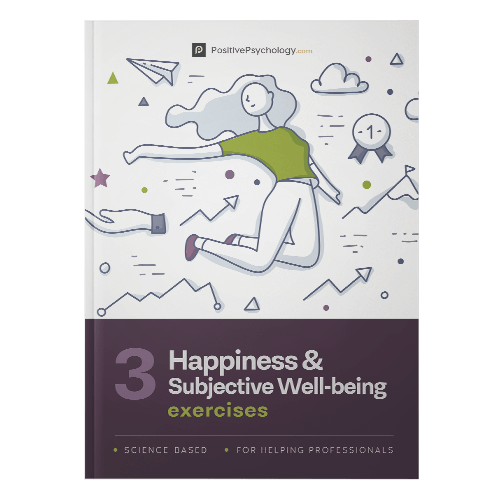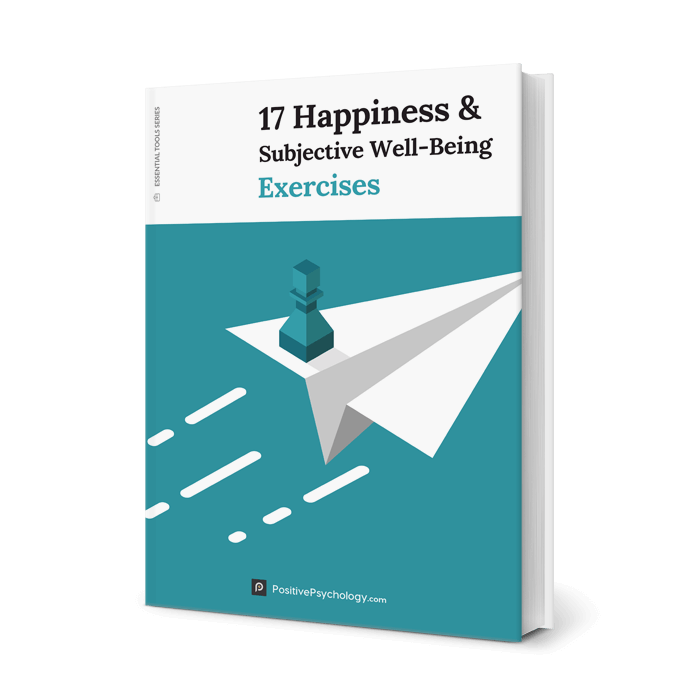6 Benefits of Happiness According to the Research
 There are very few people who would say they wouldn’t like to be happier, and it’s easy to see why.
There are very few people who would say they wouldn’t like to be happier, and it’s easy to see why.
The feeling of happiness is a wonderful experience, emotionally and mentally, and it makes sense that we’d want to create more of that in our lives.
An entire industry has sprung up around the concept of happiness, and how to cultivate more of it. From bestselling books such as The Happiness Project by Gretchen Rubin to online courses like The Science of Happiness from The Greater Good Center – there’s every resource available to help you explore your happy self.
But what about the why of doing so beyond a nice feeling?
Research is showing that bringing more happiness into your life has far more benefits than merely feeling good. Read on to find out more about what they are.
Before you continue, we thought you might like to download our three Happiness & Subjective Wellbeing Exercises for free. These detailed, science-based exercises will help you or your clients identify sources of authentic happiness and strategies to boost wellbeing.
This Article Contains:
What are the Benefits of Happiness?
It was Aristotle who once said “Happiness is the meaning and purpose of life, the whole aim and the end of human existence” – a sentiment that is still true today. While Aristotle had a philosophical notion of the importance of happiness for human well-being, today we have a range of science and research to back it up.
Scientific studies have begun to reveal a host of physical health benefits surrounding happiness including a stronger immune system, stronger resilience in the face of stress, a stronger heart and less risk of cardiovascular disease, alongside quicker recovery times when overcoming illness or surgery. There is even a body of research that indicates being happy may help us to live longer lives.
Across all of the research, there is a conflict between whether feeling happier directly leads to better health outcomes, or whether it is merely a correlation (Newman, 2015).
Some researchers have hypothesized that feeling happier and more positive leads to greater participation in activities that are healthier including exercise, eating healthy, socializing and good sleeping habits (Sin, Moskowitz, & Whooley, 2015). Either way, the two are connected, and researchers are continually seeking to explore the link further.
A Look at the Research
Below is an overview of some of the research exploring the physical health benefits of happiness:
-
- Steptoe & Wardle (2005) asked participants to rate their happiness at 30 different points in one day. Participants were asked to repeat the exercise three years later. Their findings showed that individuals who rated themselves as the happiest at both the first and later exercise were also those with a lower heart rate and blood pressure. People with lower heart rates and blood pressure are less likely to suffer from cardiovascular disease. This suggests that feelings of happiness contribute positively to these physical measurements.
- Bhattacharyya, Whitehead, Rakhit & Steptoe (2008) also found a link between happiness and heart health. The researchers studied individuals who already had, or were suspected of having coronary heart disease. They asked participants to rate their happiness, and their hearts were then tested for symptoms. Those who rated the highest for happiness on the day also had the healthiest heart patterns. This suggests that happiness can still have health benefits, even when illness or disease is already present.
- As well as heart disease, happiness has also been linked to reducing the risk of a stroke. Strokes occur when the blood flow to the brain is disrupted, resulting in a loss of physical control and responsiveness. Depending on the severity and longevity of the disruption, a stroke can have dire consequences for the individual. Ostir, Markides, Peek & Goodwin (2001) found older adults with a higher reporting of positive well-being, had a reduced likelihood of experiencing a stroke by 26%.
- Some of the earliest studies in this area have focused on the immune system. Stone et al (1987) explored the persistence of the human immune system when participants reported positive moods by having them ingest a pill that caused an immune response. Participants were asked to rate their mood across different days and then their saliva was tested for antibodies in response to the pill. Those who rated themselves the happiest had a higher level of antibodies. The results suggest that feeling more positive can help support the immune system to defend against foreign bodies.
- Two studies further explored the impact of positive emotions on the immune system. Cohen et al (2003) asked participants to rate their experience of positive emotions over a two-week period. They then exposed them to the common cold virus and checked in five days later to see who had developed a cold. Those who rated themselves as experiencing the most positive emotions in the preceding two weeks were less likely to have fallen sick. A similar study exposed participants to the hepatitis B vaccine and asked them to rate their positive emotions. Those who rated highest for positive emotions were twice as likely to have a high antibody response (Marsland et al, 2006).
- Zautra, Johnson & Davis (2005) found that happier people are better able to mitigate pain when experiencing chronic illness. Participants with chronic pain, such as arthritis, were asked to rate their positive emotions across a three-month period. Their personal experiences of pain relating to their illness were also measured. Those who reported higher ratings of positive feelings also reported fewer increases in pain. Similar studies also found these results to be consistent with participants with chronic pain (Zautra, Smith, Affleck & Tennen, 2001, and Strand et al, 2006).
Most Interesting Scientific Findings
Perhaps some of the most interesting scientific findings looking at the impact of happiness is around the connection to life longevity.
A number of studies have looked at the connection between positive emotions – including happiness – and life expectancy. A longitudinal study spanning 13 years conducted by Carstensen et al (2011) found that emotional experience (positive or negative) predicted mortality.
Participants in the study who reported more positive over negative emotions in everyday life were more likely to have survived the length of the study.
Further research seeking to explore the connection found similar results:
- Lawrence, Rogers & Wadsworth (2015) explored the impact of happiness on 32,000 participants and their survival rate over a 30-year period. Participants who were rated the least happy had a 14% higher chance of death than their happiest counterparts.
- A quantitative review of 70 observational studies explored the link between positive affect (well-being) and life expectancy, in both healthy participants and participants who had already been diagnosed with a health condition. Healthy participants who were rated as having a higher positive affect reduced their risk of death by 18%, and by 2% for those with a pre-existing condition (Chida & Steptoe, 2008).
- A further study exploring this connection also indicates that it is the consistency of life satisfaction (or happiness) that has an impact on life longevity. Boehm et al (2015) found that participants who reported a low sense of life satisfaction with a high level of variability (meaning they went through high and low phases) were more likely to die early than participants who reported a consistently low sense of satisfaction.
Researchers have speculated over why this link seems to exist, and why it is so prominent for participants who rate the highest for happiness and positive emotions. Many believe it is because individuals who are happiest, are also more inclined to engage in activities and behaviors that are positive for their overall health, including physical exercise, eating healthy, not smoking, sleeping well, and even meditation (Strine et al, 2008)
6 Proven Health Benefits of Happiness
With so much research showing the multiple positive benefits for our health when we’re happy, here are the top six proven health benefits:
1. Improved Heart Health
Several studies have linked happiness with improved heart health and lower risk of heart disease by 13-26% (Kim, Smith & Kubzansky, 2014, Boehm et al, 2011, Kubzansky & Thurston, 2007, Davidson, Mostofsky & Whang, 2010).
2. Ability to Combat Stress More Effectively
Excess stress causes higher levels of cortisol – the stress hormone – which can lead to a number of health conditions. Multiple studies have found that individuals who are happier have consistently lower cortisol levels in their blood (Smyth et al, 1998, Davydov et al, 2005, Steptoe et al 2008).
3. A Stronger Immune System
Some research has indicated that being happier can support a strong immune system, leading to greater health all round, and the ability to fight infections or disease more effectively (Stone et al, 1987, Cohen et al, 2003, Marsland et al, 2006).
4. Overall Healthier Lifestyle
Happiness has also been linked to several positive and highly beneficial health habits, that promote a greater sense of wellbeing. This includes eating a healthier diet (Dubois et al, 2012), engaging in more physical activity (Sapranaviciute-Zabazlajeva et al, 2017), and overcome poor sleeping habits (Steptoe et al, 2008).
5. Can Help Reduce Pain
Researchers believe that individuals who are happier, have a better perspective and are able to accept new thoughts easily, which can lead to a lower experience of pain especially connected to chronic conditions such as arthritis (Fredrickson, 2004, Berges, Seale & Ostir, 2014).
6. Increased Life Longevity
One of the most interesting finds from the research for health benefits of happiness is its connection with life longevity. Researchers believe that because of the impact happiness has on all of the above health benefits, it can ultimately help you live a longer life (Carstensen et al, 2011, Lawrence, Rogers & Wadsworth, 2015, Chida & Steptoe, 2008).
The research examining the connection between happiness and positive health benefits is still relatively new, and more research is continuing to emerge. That being said, it certainly seems from the current data that working on being happier will have plenty of health benefits.
The Benefits of Happiness at Work
Too many people measure how successful they are by how much money they make or the people that they associate with. In my opinion, true success should be measured by how happy you are.
Richard Branson
It’s easy to confuse success with happiness, and many people strive for professional goals (money or job titles) only to achieve them and realize it doesn’t provide them with the sense of happiness they were hoping for.
Until relatively recently, work and happiness weren’t really connected, but research is starting to show that there is a range of benefits for happy employees – for both the individual and the organization.
Some of the benefits of happiness at work include:
1. Better Decision Making & Creative Problem Solving
Happiness at work has a range of benefits for how our brains work and think. When we’re happier, we tend not to focus on the negatives or stressors as much, allowing more room to think about how to positively get on with challenges (Brockis, 2019).
2. Improved Individual and Team Productivity
Sgroi (2015) in a study for the University of Warwick found that happier employees tended to be 12% more productive, whereas unhappy employees were up to 10% less productive.
3. Better Customer Service Satisfaction
A study from Gallup (2017) found that happier employees were more engaged, which resulted in improved customer relationships, and a 20% increase in sales. When we feel happy, we’re more likely to express ourselves positively and want to help those around us.
4. It Might Help You Earn More
Tang (2006) found that feelings in life satisfaction were linked to higher salaries, however, this wasn’t consistent, and varied between genders. It’s also difficult to determine whether having a higher salary led to greater life satisfaction due to having fewer financial stressors.
5 Things You Can Do to Realize These Benefits in Your Life
Trying to feel happier in life might seem like a mammoth task to take on, but it doesn’t have to be. A few simple practices each day have been proven to help you realize and begin to reap the benefits of happiness:
1. Practice Gratitude
It’s easy to complain when things go wrong or you get stuck in the rut of thinking ‘why has this happened to me’ when you have a bad day, but practicing gratitude can help tackle that and improve feelings of happiness. Simply writing down three things you feel grateful for before bed can work wonders on your mindset (Emmons & McCullough, 2003).
2. Incorporate Some Movement
Exercise releases endorphins, which have a direct impact on our mood – in a good way! Adding in some aerobic exercise is proven to be effective in increasing feelings of happiness (Netz et al., 2005). This doesn’t have to be hitting the gym, it could be as simple as putting on your favorite music and dancing in the living room.
3. Get Back in Touch with Nature
Combine your aerobic exercise with nature and you’ll be onto something good. Spending time outdoors has been proven to aid our moods (Barton & Pretty, 2010). A good walk or run in a local park or woods or some gardening can spark some wonderful benefits.
4. Practice Mindfulness
Incorporating mindfulness can help you create better awareness for your everyday feelings, and let go of negative experiences, allowing for more room to appreciate positive experiences and emotions (Campos et al, 2016).
5. Spend Time with Loved Ones
Socializing with friends and loved ones have many health benefits (Troyer, 2016), including feelings of well-being and happiness. Making time for coffee with friends, or quality time with family members is a great way to realize the benefits of happiness.
A Take-Home Message
I hope you’ve enjoyed reading more about the different health benefits of happiness, I know I enjoyed researching them! If there’s one thing I want you to take away from this article, it’s that cultivating more happiness or positive emotions shouldn’t become an exercise to be added to the ‘To-Do’ list.
Research shows that feeling happier is beneficial for our health, but not if forcing yourself to be happy or seek out happiness ends up causing you more stress.
Take your time and enjoy the process of identifying areas of life where you could potentially let some more happiness in.
Have you managed to cultivate greater happiness in your life? How did you do it? Please share your experiences in the comments, I’d love to hear about them.
We hope you enjoyed reading this article. Don’t forget to download our three Happiness Exercises for free.
- Barton, J. & Pretty, J. (2010). What is the best dose of nature and green exercise for improving mental health? A multi-study analysis. Retrieved from: https://www.ncbi.nlm.nih.gov/pubmed/20337470
- Berges, I. M., Seale, G., & Ostir, G. V. (2014). Positive Affect and Pain Ratings in Persons with Stroke. Retrieved from: https://www.ncbi.nlm.nih.gov/pmc/articles/PMC3063951/
- Bhattacharyya, M. R., Whitehead, D. L., Rakhit, R., & Steptoe, A. (2008). Depressed mood, positive affect, and heart rate variability in patients with suspected coronary artery disease. Retrieved from: https://www.ncbi.nlm.nih.gov/pubmed/18941130
- Boehm, J. K., Peterson, C., Kivimaki, M., & Kubzansky, L. D. (2011). Heart health when life is satisfying: evidence from the Whitehall II cohort study. Retrieved from: https://www.ncbi.nlm.nih.gov/pubmed/21727096
- Boehm, J. K., Winning, A., Segerstrom, S., & Kubzansky, L. (2015). Variability Modifies Life Satisfaction’s Association With Mortality Risk in Older Adults. Retrieved from: https://www.ncbi.nlm.nih.gov/pubmed/26048888
- Brockis, J. (2019). Why Happiness at Work Matters. Retrieved from: https://www.drjennybrockis.com/2019/1/24/happiness-work-matters/
- Campos, D., Cebolla, A., Quero, S., Breton-Lopez, J., Botella, C., Soler, J., Garcia-Campayo, J., Demarzo, M., & Banos, R. M. (2016). Meditation and happiness: Mindfulness and self-compassion may mediate the meditation–happiness relationship. Retrieved from: https://www.sciencedirect.com/science/article/pii/S0191886915005450
- Carstensen, L. L., Turan, B., Schiebe, S., Ram, N., Ersner-Hershfield, H., Samanez-Larkin, G. R., Brooks, K. P., & Nesselroad, J. R. (2011). Emotional experience improves with age: evidence based on over 10 years of experience sampling. Retrieved from: https://www.ncbi.nlm.nih.gov/pubmed/20973600
- Chida, Y. & Steptoe, A. (2008). Positive psychological well-being and mortality: a quantitative review of prospective observational studies. Retrieved from: https://www.ncbi.nlm.nih.gov/pubmed/18725425
- Cohen, S., Doyle, W. J., Turner, R. B., Alper, C. M., & Skoner, D. P. (2003). Emotional style and susceptibility to the common cold. Retrieved from: https://www.ncbi.nlm.nih.gov/pubmed/12883117
- Davidson, K. W., Mostofsky, M., & Whang, W. (2010). Don’t worry, be happy: positive affect and reduced 10-year incident coronary heart disease: The Canadian Nova Scotia Health Survey. Retrieved from: https://www.ncbi.nlm.nih.gov/pmc/articles/PMC2862179/
- Davydov, D. M., Shapiro, D., Goldstein, I. B., & Chicz-DeMet, A. (2005). Moods in everyday situations: effects of menstrual cycle, work, and stress hormones. Retrieved from: https://www.ncbi.nlm.nih.gov/pubmed/15992570
- Emmons, R. A. & McCullough, M. E. (2003). Counting blessings versus burdens: an experimental investigation of gratitude and subjective well-being in daily life. Retrieved from: https://www.ncbi.nlm.nih.gov/pubmed/12585811
- Fredrickson, B. L. (2004). The broaden-and-build theory of positive emotions. Retrieved from: https://www.ncbi.nlm.nih.gov/pmc/articles/PMC1693418/pdf/15347528.pdf
- Gallup (2007). The State of the American Workplace. Retrieved from; https://news.gallup.com/reports/199961/7.aspx
- Kim, E. S., Smith, J., & Kubzansky, L. D. (2014). A Prospective Study of the Association Between Dispositional Optimism and Incident Heart Failure. Retrieved from: https://www.ncbi.nlm.nih.gov/pmc/articles/PMC4608236/
- Kubzansky, L. D. & Thurston, R. C. (2007). Emotional vitality and incident coronary heart disease: benefits of healthy psychological functioning. Retrieved from: https://www.ncbi.nlm.nih.gov/pubmed/18056547
- Lawrence, E. M., Rogers, R. G., & Wadsworth, T. (2015). Happiness and Longevity in the United States. Retrieved from: https://www.ncbi.nlm.nih.gov/pmc/articles/PMC4724393/
- Marsland, A., Cohen, S., Rabin, B. S., & Manuck, S. B. (2006). Trait positive affect and antibody response to hepatitis B vaccination. Retrieved from: https://www.sciencedirect.com/science/article/pii/S088915910500139X
- Newman, K. M. (2015). Six Ways Happiness Is Good for Your Health. Retrieved from: https://greatergood.berkeley.edu/article/item/six_ways_happiness_is_good_for_your_health
- Ostir, G. V., Markides, K. S., Peek, M. K., & Goodwin, J.S. (2001). The association between emotional well-being and the incidence of stroke in older adults. Retrieved from: https://www.ncbi.nlm.nih.gov/pubmed/11292267
- Sapranaviciute-Zabazlajeva, L., Luksiene, D., Virciciute, D., Bobak, M., & Tamosiunas, A. (2017). Link between healthy lifestyle and psychological well-being in Lithuanian adults aged 45–72: a cross-sectional study. Retrieved from: https://www.ncbi.nlm.nih.gov/pmc/articles/PMC5387968/
- Sin, N. L, Moskowitz, J. T., & Whooley, m. A. (2015). Positive Affect and Health Behaviors Across 5 Years in Patients With Coronary Heart Disease: The Heart and Soul Study. Retrieved from: https://www.ncbi.nlm.nih.gov/pubmed/26428445
- Sgroi, D. (2015). Happiness and Productivity: Understanding the Happy Productive Worker. Retrieved from: https://warwick.ac.uk/fac/soc/economics/staff/dsgroi/impact/hp_briefing.pdf
- Smyth, J., Ockenfels, M. C., Porter, L., Kirschbaum, C., Hellhammer, D. H., & Stone, A. A. (1998). Stressors and mood measured on a momentary basis are associated with salivary cortisol secretion. Retrieved from: https://www.ncbi.nlm.nih.gov/pubmed/9695136
- Steptoe, A. & Wardle, J. (2005). Positive affect and biological function in everyday life. Retrieved from: https://www.sciencedirect.com/science/article/pii/S0197458005002769
- Steptoe, A., O’Donnell, K., Marmot, M., & Wardle, J. (2008). Positive affect, psychological well-being, and good sleep. Retrieved from: https://www.ncbi.nlm.nih.gov/pubmed/18374740
- Stone, A. A., Cox, D. S., Valdimarsdottier, H., Jandorf, L., & Neale, J. M. (1987). Evidence that secretory IgA antibody is associated with daily mood. Retrieved from: https://www.ncbi.nlm.nih.gov/pubmed/3585705
- Strand, E. B., Zautra, A. J., Thoresen, M., Ødegård, S., Uhlig, T., & Finset, A. (2006). Positive affect as a factor of resilience in the pain-negative affect relationship in patients with rheumatoid arthritis. Retrieved from: https://www.ncbi.nlm.nih.gov/pubmed/16650588
- Strine, T. W., Chapman, D. P., Balluz, L. S., Moriarty, D. G., & Mokdad, A. H. (2008). The associations between life satisfaction and health-related quality of life, chronic illness, and health behaviors among U.S. community-dwelling adults. Retrieved from: https://www.ncbi.nlm.nih.gov/pubmed/18080207
- Tang, T. L. P. (2006). Income and Quality of Life: Does the Love of Money Make a Difference? Retrieved from: https://link.springer.com/article/10.1007/s10551-006-9176-4
- Troyer, A. K. (2016). The Health Benefits of Socializing. Retrieved from: https://www.psychologytoday.com/au/blog/living-mild-cognitive-impairment/201606/the-health-benefits-socializing
- Zautra, A. J., Smith, B., Affleck, G., & Tennen, H. (2001). Examinations of chronic pain and affect relationships: applications of a dynamic model of affect. Retrieved from: https://www.ncbi.nlm.nih.gov/pubmed/11680555
- Zautra, A. J., Johnson, L. M., & Davis, M. C. (2005). Positive Affect as a Source of Resilience for Women in Chronic Pain. Retrieved from: https://www.ncbi.nlm.nih.gov/pmc/articles/PMC2593933/
Let us know your thoughts
Read other articles by their category
- Body & Brain (49)
- Coaching & Application (57)
- Compassion (26)
- Counseling (51)
- Emotional Intelligence (24)
- Gratitude (18)
- Grief & Bereavement (21)
- Happiness & SWB (40)
- Meaning & Values (26)
- Meditation (20)
- Mindfulness (45)
- Motivation & Goals (45)
- Optimism & Mindset (34)
- Positive CBT (28)
- Positive Communication (20)
- Positive Education (47)
- Positive Emotions (32)
- Positive Leadership (18)
- Positive Parenting (4)
- Positive Psychology (33)
- Positive Workplace (37)
- Productivity (16)
- Relationships (46)
- Resilience & Coping (36)
- Self Awareness (21)
- Self Esteem (38)
- Strengths & Virtues (32)
- Stress & Burnout Prevention (34)
- Theory & Books (46)
- Therapy Exercises (37)
- Types of Therapy (64)





What our readers think
Great post : )
I think that when you realize that you can only do two things in life: REACT to it, or CREATE it, everything changes.
Because, when you don’t need things outside to change for you to feel something you want, (reacting), then being happy becomes a decision (creating)… a decision of how you are going to process all the world around you, regardless of how things are.
Getting there is just freedom… and freedom feels good : )
Love you all.
Alem.